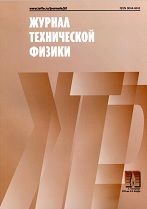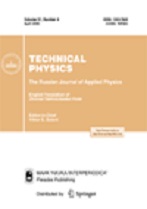|
|
Zhurnal Tekhnicheskoi Fiziki, 2016, Volume 86, Issue 3, Pages 106–109
(Mi jtf6610)
|
 |
|
 |
This article is cited in 3 scientific papers (total in 3 papers)
Solid-State Electronics
Powerful diode nanosecond current opening switch made of $p$-silicon ($p$-SOS)
I. V. Grekhov, A. G. Lyublinsky, E. I. Belyakova
Ioffe Institute, St. Petersburg
Abstract:
The nanosecond semiconductor diode-based opening switch (SOS-diode) capable of switching currents with densities up to several tens of kiloamperes per cubic centimeter represents a $p^{+}p'$Nn$^{+}$ silicon structure fabricated by the deep simultaneous diffusion doping (to about 200 $\mu$m) of $n$-Si by Al and B from one side and P from the other. In the SOS mode, first a short pulse of forward current passes through the diode and then a fast-growing pulse of reverse voltage is applied. A resulting pulse of reverse current carries away injected holes and thereby forms a plasma front in the $p'$ layer, which moves toward the $p'N$ junction. When the hole concentration in the flow exceeds the dopant concentration in the $p'$ layer, a space charge region arises in this layer, the resistivity of the diode increases sharply, and the current switches to a load connected parallel to the diode. Early results concerning an alternative configuration of the SOS diode are presented. Here, the diode was made by the rapid simultaneous diffusion of B and P from the opposite sides of a $p$-Si wafer to a depth of 60–80 $\mu$m. If a short pulse of forward current is passed through such a $p^+pn^+$ structure and a pulse of reverse voltage is then applied, a plasma front arising in the $p^+$ region moves toward the $p^+p$ interface through the heavily doped (i.e., low-resistivity) $p^+$ region. Having crossed this interface, the front passes into a low-doped region, where the hole concentration in the flow becomes much higher than the dopant concentration and a space charge region causing the current to pass to the load forms at once. It is shown experimentally that, all other things being the same, the time of current breaking in the $p$-SOS-diode is roughly twice as short as in the conventional $n$-SOS-diode, switched currents are considerably lower, and the fabrication technique of $p$-SOS-diodes is much simpler. Ways of optimizing the design of the semiconductor structure of the $p$-SOS-diode to further raise the speed are outlined.
Keywords:
Dopant Concentration, Space Charge Region, Semiconductor Structure, Current Interruption, Reverse Voltage.
Received: 02.07.2015
Citation:
I. V. Grekhov, A. G. Lyublinsky, E. I. Belyakova, “Powerful diode nanosecond current opening switch made of $p$-silicon ($p$-SOS)”, Zhurnal Tekhnicheskoi Fiziki, 86:3 (2016), 106–109; Tech. Phys., 61:3 (2016), 424–427
Linking options:
https://www.mathnet.ru/eng/jtf6610 https://www.mathnet.ru/eng/jtf/v86/i3/p106
|


| Statistics & downloads: |
| Abstract page: | 33 | | Full-text PDF : | 18 |
|





 Contact us:
Contact us: Terms of Use
Terms of Use
 Registration to the website
Registration to the website Logotypes
Logotypes








 Citation in format
Citation in format 
